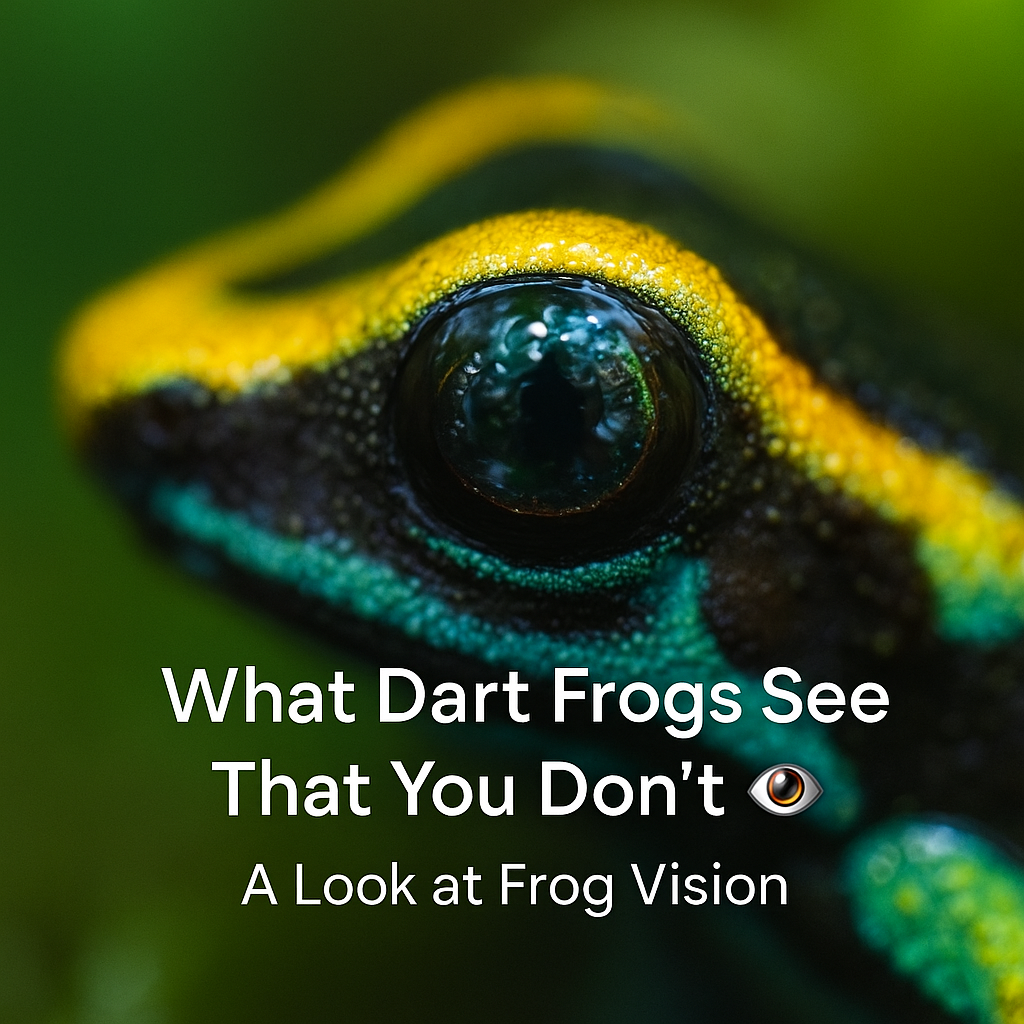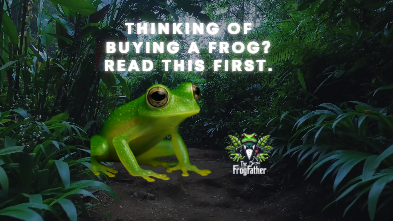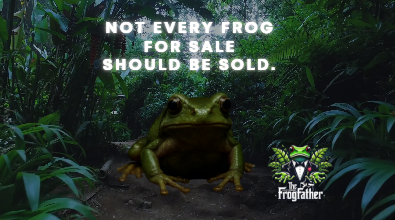If you’ve read our story Through the Frog’s Eyes, you’ve already met Ray — a Ranitomeya variabilis who wakes each morning beneath a canopy of mist and light. What Ray sees, however, is not what we see. His world glows in wavelengths we can’t perceive, shaped by ultraviolet light, reflection, and motion. Understanding how dart frogs see is more than a curiosity — it’s the foundation for creating environments that truly meet their needs.
How Dart Frog Eyes Work
Dart frogs belong to a group of amphibians with remarkably advanced vision for their size. Their large, forward-facing eyes give them a wide field of view and strong depth perception — crucial for spotting small prey in dense foliage. But the real magic lies in the structure of their retinas.
Where human eyes rely on three types of cone cells (red, green, blue), frogs have four. This extra cone allows them to detect ultraviolet (UV) light, expanding their visible spectrum into wavelengths invisible to us. In practice, this means a frog can distinguish between surfaces that look identical to us but reflect UV differently — for example, between two leaves, one sunlit and one in shadow.
Seeing in Ultraviolet
Frogs’ ability to see ultraviolet light helps them in several ways. In the wild, UV cues help them identify safe basking spots, locate food, and even recognise other frogs. Some species use subtle UV patterns on their skin as signals — invisible to predators, but visible to other frogs. It’s an evolutionary advantage that combines camouflage and communication.
In captivity, this sensitivity means the quality of light inside a vivarium directly affects behaviour. Under poor lighting, frogs may appear duller, move less, or display reduced feeding response. A vivarium lit with high-quality, full-spectrum LEDs — such as the Arcadia Jungle Dawn Light Risers — allows them to perceive their world more naturally, maintaining healthy circadian rhythms and encouraging natural behaviour.
How Motion Defines Their World
Dart frogs are acutely sensitive to movement. Their eyes are tuned to detect subtle shifts in light and shadow, which helps them spot tiny insects, mites, or springtails from several centimetres away. Unlike humans, who can fix their gaze, frogs rely on constant scanning — a reflexive motion that keeps the world alive in their vision.
This motion sensitivity also affects how they perceive humans. Quick, sudden movement near the glass is far more alarming than a slow approach. When building or maintaining a vivarium, it’s best to move gently, giving them time to interpret the change in light and vibration. What feels like a brief adjustment to us might feel like a predator’s shadow to them.
Focus, Distance, and Reflection
Unlike mammals, frogs do not focus by changing the shape of the lens. Instead, they move the entire lens closer or further from the retina. This mechanism is ideal for small distances — exactly what’s needed in a densely planted vivarium. However, it makes them less effective at perceiving detail across long distances, which is why they thrive in environments where everything they need is within a few hops.
Glass reflection plays an interesting role. To us, it’s an aesthetic element — a sign of moisture or lighting. To frogs, it’s a potential boundary. When a vivarium is too reflective, it can cause confusion or stress, as the frog may interpret its own reflection as another animal. Positioning lighting slightly off-centre or using soft misting cycles can reduce glare and create a more realistic spatial sense for them.
How Light Affects Behaviour
Lighting isn’t just about visibility — it’s about biology. Frogs rely on light to regulate sleep, metabolism, and reproduction. In nature, the rainforest canopy filters sunlight into complex patterns of brightness and colour. Captive frogs rely on us to recreate that.
Full-spectrum systems like the Arcadia Jungle Dawn LEDs are designed to mimic these natural conditions. When paired with the 3D-printed Jungle Dawn Light Risers, they distribute light evenly across the enclosure, preventing hotspots and ensuring even coverage of UV and visible light. This helps frogs like Ray interpret their environment more accurately — from choosing hunting spots to selecting calling perches.
Behavioural studies have shown that when frogs are kept under high-quality lighting with gradual day-night transitions, they display stronger feeding responses, brighter colouration, and more frequent social behaviours. It’s a direct reflection of how closely their vision is tied to their wellbeing.
The Role of Colour and Contrast
Humans tend to see colour as a decorative feature, but for frogs, it’s a vital environmental cue. The rich greens and browns of a bioactive vivarium aren’t just aesthetic; they help frogs orient themselves and identify movement. Colour contrast helps them determine safe paths and locate potential prey.
Interestingly, frogs may also perceive some artificial colours differently. Bright synthetic ornaments or plastics can reflect in unnatural ways under UV, creating confusing visual signals. Whenever possible, use bioactive substrates and live plants — they produce more natural light patterns and maintain consistent humidity, helping frogs navigate comfortably.
Depth and 3D Perception
With their wide-set eyes and overlapping fields of view, dart frogs possess excellent binocular vision at short range. This gives them the ability to judge depth accurately when leaping or targeting prey. Their pupils adjust rapidly to light intensity, protecting their retinas while maintaining sensitivity in dim forest light.
It’s this combination — UV sensitivity, motion detection, and depth perception — that allows a frog to survive in an environment full of shifting shadows. To them, the vivarium isn’t static; it’s constantly alive with subtle light changes and movement we can’t see.
Understanding Vivarium Light Cycles
A consistent light cycle is critical for frog health. Sudden or irregular changes in brightness can disrupt feeding and breeding behaviours. For most species, a 12-hour light cycle works well, with gentle dawn and dusk transitions to simulate canopy conditions. Smart plugs or timers can automate this process to ensure consistency.
When misting systems activate, the combination of moisture and light produces natural refractive effects that frogs are attuned to. This moment — when droplets scatter light through the air — often triggers activity. It’s why many frogs begin exploring or calling immediately after misting.
Practical Lighting Recommendations
- Use full-spectrum LED or T5 lighting with UV coverage suitable for amphibians.
- Mount lighting high enough to avoid glare and direct eye exposure.
- Combine with a misting schedule that simulates natural humidity cycles.
- Position reflective surfaces thoughtfully to avoid confusing reflections.
- Provide shaded areas to allow frogs to regulate exposure naturally.
Frog Vision in Research
Scientific studies have revealed how amphibian vision evolved as a balance between water and land. Frogs retain many ancestral traits, including sensitivity to polarised light — a feature that helps them detect the surface of water and judge direction under varying light angles. Some research even suggests that certain dart frogs use this visual data to navigate complex terrain and locate territories.
While the exact colour ranges vary by species, most dart frogs can detect beyond 380 nanometres into the UV spectrum. For comparison, humans see from roughly 400 to 700 nanometres. This extra sensitivity explains why lighting quality directly affects frog behaviour — it’s not about brightness, but spectral accuracy.
So, in a nutshell…
When we build a vivarium, we’re not just creating an enclosure; we’re shaping a world. For frogs like Ray, that world is made of light and motion. Every reflection, every droplet, every subtle beam defines how they move, feed, and interact. Understanding how they see is the first step toward designing spaces that don’t just look natural — they feel natural to the animals within.
So next time you mist your tank or adjust your lighting, imagine it from their side of the glass. You might realise there’s far more colour in your vivarium than you ever knew existed.
❓ FAQ
Q: Can dart frogs see ultraviolet light?
Yes — dart frogs have an extra cone in their eyes that allows them to detect ultraviolet light, helping them navigate and communicate in ways humans can’t perceive.
Q: What kind of lighting is best for dart frogs?
Full-spectrum LEDs like Arcadia Jungle Dawn provide balanced UV and visible light, replicating natural canopy conditions and promoting healthy behaviour.
Q: Do reflections bother frogs?
Yes, strong reflections can confuse frogs as they may mistake them for other animals. Position lighting to reduce glare and maintain natural light balance.
Q: Does lighting affect dart frog colour?
Indirectly — proper UV and visible light improve their mood, feeding response, and overall colour vibrancy by stimulating healthy skin pigments.



